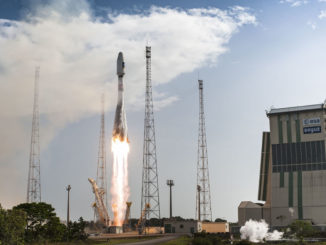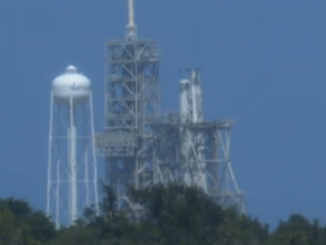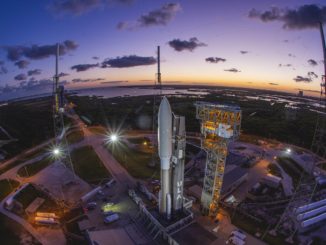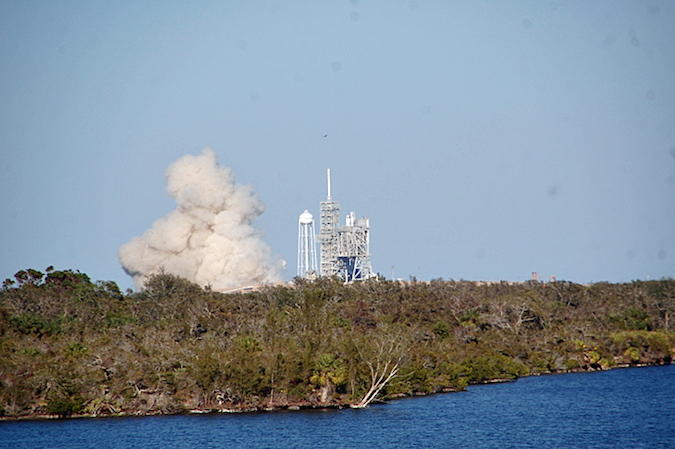
Nine Merlin engines ignited and throttled up to nearly 2 million pounds of thrust Sunday during a brief hold-down firing of SpaceX’s Falcon 9 rocket, sending a plume of smoke out of the flame trench at Kennedy Space Center’s historic launch pad 39A as the company preps for a space station cargo mission next weekend.
The Merlin 1D engines on the rocket’s first stage were programmed to fire for about three-and-a-half seconds, reaching full power with around 1.7 million pounds of thrust as the Falcon 9 booster remained affixed to the seaside launch complex.
Onlookers at Kennedy Space Center reported visible venting of super-chilled liquid oxygen vapors from the rocket leading up to the static fire test, then a white cloud of rocket exhaust rushing out of the north side of the launch pad as the Merlin engines ignited at 4:30 p.m. EST (2130 GMT).
SpaceX confirmed a few minutes later that the static fire was successfully completed, and engineers are reviewing data collected during the test.
Sensors in each engine were to measure many performance parameters during the brief ignition at the launch pad. Hold-down restraints kept the rocket on the ground.
The hotfire test marked the first time a rocket ignited at pad 39A since July 8, 2011, when the final space shuttle mission blasted off there. The launch complex sat dormant for three years until SpaceX signed a 20-year lease to take over the pad in 2014.
The milestone static fire test is a major step leading to SpaceX’s first-ever launch from pad 39A scheduled for next Saturday, Feb. 18, with a Dragon supply ship carrying 5,266 pounds (2,389 kilograms) of equipment and experiments to the International Space Station.
If the rocket takes off Feb. 18, the Dragon spacecraft will reach the research lab in orbit Feb. 20.
It will be SpaceX’s first resupply launch to the space station since last July, before a Falcon 9 rocket exploded on the Complex 40 launch pad at nearby Cape Canaveral Air Force Station.
The explosion grounded the Falcon 9 rocket for the rest of 2016, and left Complex 40 with significant damage requiring repairs.
Preparations at pad 39A took on a feverish pace in the months since the Sept. 1 explosion at pad 40, which sits on Air Force property a few miles south of pad 39A.
The crucial static fire test doubled as a check of the rocket’s readiness for flight and the function of the launch pad’s fueling, telemetry and water deluge systems, all of which were overhauled by SpaceX in recent months.
With the test completed, ground crews will lower the rocket and attach the Dragon cargo freighter for launch next weekend.
Hans Koenigsmann, SpaceX’s vice president of flight reliability, said Wednesday that testing of the new ground systems at 39A was nearly complete, allowing managers to move ahead with rollout of the rocket.
“This is a huge pad,” Koenigsmann said. “The runs from the LOX (liquid oxygen) farm and the fuel farm down to the launch head are huge. The transporter-erector is huge. It’s like one-and-a-half million pounds of steel, and (it has) so much technology because this thing controls all the interfaces (with the rocket).”
The transporter-erector will carry rockets from the hangar up the incline to the pad, then lift the vehicles vertical. The rocket carrier was observed vertical at pad 39A in the last few weeks during testing.
“There was nothing in particular that gave us a hard time,” Koenigsmann told reporters Wednesday during the Federal Aviation Administration’s 20th Annual Commercial Space Transportation Conference in Washington. “It’s more like this whole thing was a huge effort, and at the end of it you want to test and test things again to make sure that they’re ready to go.”
SpaceX resumed launches Jan. 14 with a successful Falcon 9 mission from Vandenberg Air Force Base in California, but the company’s return-to-flight in Florida has been paced by the construction at pad 39A.
NASA launched 12 Saturn 5 rockets from pad 39A during the Apollo moon program — including Apollo 11 — and 82 shuttle flights departed from the seaside launch complex.
But NASA decided it no longer needed pad 39A after the shuttle’s retirement. Nearby launch pad 39B, previously built for Apollo and shuttle flights, will be home to NASA’s Space Launch System, a government-owned heavy-lift rocket that will launch astronaut crews on deep space expeditions.
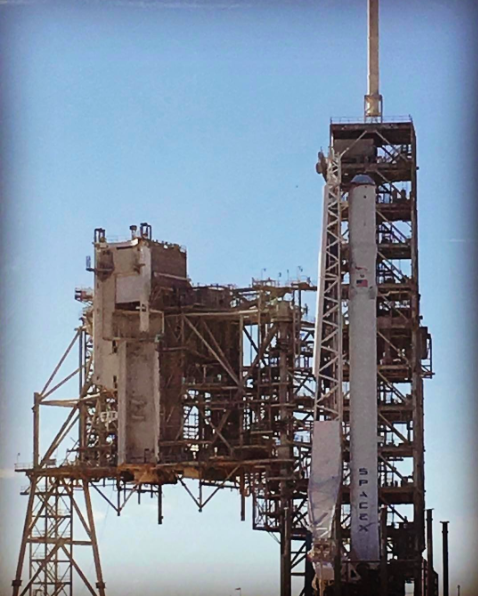
The concrete foundation of pad 39A dates back to the Apollo era of the 1960s, while the 347-foot-tall (106-meter) fixed service structure and lightning tower were emplaced before the first shuttle launch.
“It gives me a little bit of chills when I walk out there and see stuff that’s left over from Apollo,” Koenigsmann said.
Since SpaceX took over, changes to pad 39A have included the construction of the new rocket hangar outside the south gate to the facility, where space shuttles and Saturn 5 moon rockets arrived on top of tracked crawler-transporters after rollout from the nearby Vehicle Assembly Building.
The hangar can accommodate five Falcon 9 rocket cores at a time, according to SpaceX.
Other additions include the installation of RP-1 kerosene fuel tanks and the construction of the massive transporter-erector, which is sized to accommodate SpaceX’s powerful triple-body Falcon Heavy rocket when it debuts later this year.
“The transporter-erector is big enough to do Falcon Heavy. We can launch Falcon 9 with it in the center, of course, but the Falcon Heavy drives the size of it,” Koenigsmann said. “You can see … It’s bigger than the one we used to have.”
The facility’s water system has also been refurbished to provide acoustic and heat protection to the pad deck during liftoffs, and the water tower at the northeast perimeter of the pad has been repainted, now emblazoned with the SpaceX logo.
Later this year, SpaceX plans to add an access arm to pad 39A’s fixed service structure for astronaut crews to board a human-rated version of the Dragon spacecraft beginning in 2018. SpaceX and Boeing have contracts with NASA to develop commercial spaceships to rotate crews between Earth and the space station.
SpaceX officials intend to base crewed launches and Falcon Heavy missions from pad 39A, and flights for the U.S. military and some commercial missions will be launched from pad 40 a few miles to the south.
Pad 40 should be ready for launches again in a few months after ground teams finish clean-up and repairs following the explosion of a Falcon 9 booster there in September.
SpaceX said the construction crew working at pad 39A will move over to pad 40 in the coming weeks. A firm timetable for pad 40’s availability for launches will be better known once repairs begin, but the facility could be ready by the middle of the year, officials said.
SpaceX aims to launch once every two weeks after pad 39A is inaugurated later this month, continuing with the deployment of an EchoStar communications satellite in early March, then the launch of an SES telecom payload aboard a previously-flown first stage booster later in March.
Email the author.
Follow Stephen Clark on Twitter: @StephenClark1.

